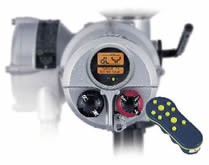Rotork IQPro electric valve actuators with the SIL (Safety Integrity Level) option

Rotork IQPro has a multi-lingual communication capability
Reliability has always been the overriding priority for Rotork valve actuator design, and now Rotork IQPro intelligent electric valve actuators are available with a Safety Integrity Level (SIL) option for applications requiring SIL2 and SIL3 levels. Rotork’s SIL qualification has been certified by T?V, the leading international organisation providing testing, certification and qualification services.
What is SIL?
Safety Integrity Level (SIL) is defined as a relative level of risk reduction provided by a safety function.
Four SIL levels are defined, with SIL4 being the most dependable and SIL1 the least. A SIL is determined through the consideration of quantitative factors in combination with qualitative factors such as development processes and safety life cycle management.
The international standard IEC 61508 defines SIL using requirements grouped into two broad categories - hardware safety integrity and systematic safety integrity. A device such as a valve actuator must meet the requirements for both categories to achieve a given SIL.
A full description of SIL requirements would take up too much space in this article. Suffice to say that hardware safety integrity is calculated by performing a failure modes and effects analysis (FMEA). The actual targets required vary depending on the likelihood of a demand, the complexity of the device and the types of redundancy adopted.
The SIL requirements for systematic safety integrity define a set of techniques and measures required to prevent systematic failures (through ‘bugs’, for example) from being designed into the device or system.
Rotork’s SIL qualification is certified to IEC61508 with the addition of IEC61511, which is a specific adaptation of IEC61508 for the process industry. This standard is used in the petrochemical and hazardous chemical industries, among others.
Rotork IQPro actuators are certified for SIL2 and SIL3 levels of safety. SIL2 applications relate to a 1 out of 1 (1oo1) actuator installation, whilst the increased safety level inherent in SIL3 demands a 1 out of 2 (1oo2) configuration.
How does it work?
Rotork’s IQPro actuators with SIL certification are equipped with the Rotork SIL safety PCB assembly, which monitors the standard IQ/IQT control board and provides diagnostic coverage and redundant control in order to perform the desired safety function if an invalid command signal is generated and/or if the standard actuator control system fails. A safety function status relay provides indication of the actuator availability and redundant safety function operation, with the same status duplicated locally on the actuator display. The SIL safety PCB can be specified with any new IQ or IQT actuator or retrofitted to existing actuators supplied since 2000.
Safety functions -
Stayput and ESD
The two safety functions applicable to valve actuators are Stayput (High Demand) and Emergency Shutdown (ESD) (Low Demand).
Available with IQ and IQT actuators, the Stayput function dictates that the actuator shall not move without a valid remote open or close command signal. If an internal failure is detected the actuator will give an alarm signal.
Dual hardwired control input signals are required for remote control. Signals must be maintained "push to run" only.
Available only with IQ actuators, the ESD function will ensure that the actuator will perform the commissioned ESD action (open, close, stayput) if an ESD signal is active. Again, if an internal failure is detected the actuator will give an alarm signal.
The ESD signal must be derived from a contact breaking and must be maintained during ESD.
Combined Stayput and ESD safety functions can also be provided with IQ actuators only. In this configuration the actuator will Stayput or else perform the ESD function, with the ESD having priority.
SIL commissioning settings are programmed into the actuator using the hand held setting tool and "non-intrusive" infra-red link, following the dedicated SIL menu on the actuator’s display screen. Once set, SIL actuators must only be operated by remote control. Local controls are therefore padlocked in the "remote" configuration and hand-auto levers similarly padlocked in the neutral position to prevent the handwheel being operated.

| Telephone: | 0113 256 7922 |
| Email: | mail@rotork.com |
| Website: | www.rotork.com |
| More information on the Rotork UK BVAA Member Directory Page |







-web.jpg)





